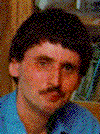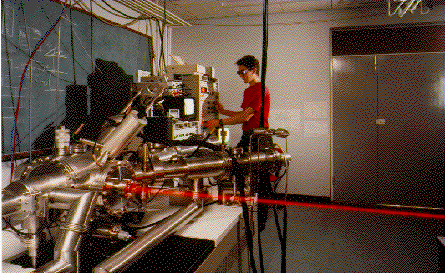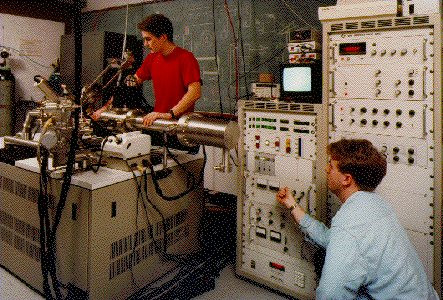The Staff

Current Research
 RIS using tunable dye lasers.
RIS using tunable dye lasers.
 VG Time of Flight mass spec.
VG Time of Flight mass spec.
Resonance Ionisation Mass Spectroscopy (RIMS) Laboratory.
One of the major lines of research at the Department of Physics in Swansea is Laser Physics. At present the Laser and Computational
Physics Research Group has five permanent members of staff, two or
three research assistants and usually around 15 to 20 postgraduate
students of whom some are overseas students. This international flavour is en
hanced through various links to other European universities and research
institutions in France, Germany, Italy and Spain, as well as to
universities in China, Mexico, Russia and the
USA.
Postgraduate research programmes offered in the Laser and Computational
Physics Group are mainly geared to experimental work but increasingly also
complementary theoretical studies are undertaken. These studies can be pursued
according to the following degree and exchange schemes:
Ph.D. degree
M.Phil. degree (by research)
M.Sc. degree
short research stays (e.g. under the European ERASMUS programme)
Four major fields of research are currently being undertaken which are
interlinked to a certain degree:
(i) the development of laser sources,
(ii) laser spectroscopy of atoms and molecules,
(iii) analytical laser spectroscopy, and
(iv) theoretical modelling of phenomena related to topics.
(i) - (iii).
Development of Lasers
Although lasers are now well established
having been available for nearly three decades there is still lively research
under way throughout the world to improve on previous designs, or to find
new types of lasers. Here at Swansea we are involved in the investigation and development of small- scale cw diode laser systems and pulsed
tunable lasers.
Tunable cw Diode Laser Systems
A major programme is under way to investigate cw diode lasers,
operating in the red and near IR, with the aim of designing, constructing and operating tunable, narrow-bandwidth (single longitudinal mode) laser systems. The lasers are based on the principles of combined current and temperature tuning, in conjunction with an external laser cavity.
In addition to the capability of wide tunability,
schemes for ultra-stable frequency locking are explored, with the aim of short and long term reproducibility of the laser wavelength. This latter aspect is pursued in collaboration with industrial partners. It is planned to amplify the output from these diode laser systems, and frequency shift the laser radiation towards wavelengths in the visible. Diode lasers are or will be used in a number of spectroscopic and analytical applications in our
laboratories.
Tunable pulsed Laser Systems
A number of commercial and in-house built dye lasers are in
operation, pumped by excimer, copper vapour and Nd:YAG lasers. Substantial improvements for narrow linewidth and low noise are often indispensible for sensitive applications in spectroscopy. We are investigating in particular cavity schemes based on the principle of grazing incidence gratings to operate our in-house built lasers in single longitudinal mode, and to improve on the spatial intensity distribution in the beam profile. For the commercial lasers schemes are being designed and investigated
to overcome some persisting problems with ASE background radiation.
Like elsewhere efforts are under way to partially, or fully, replace tunable dye lasers with tunable solid-state lasers. The optical material Ti:sapphire is now successfully and widely used for this purpose. The laser system being developed in this laboratory is based on a design using a grating under
grazing incidence. The operating range of this laser system, pumped by the 2 nd harmonic of a Nd:YAG laser, is extended into the visible and near UV exploiting frequency conversion
techniques like doubling and parametric amplification.
Further efforts are under way to implement pulse shortening to allow the generation of laser pulses of picosecond and sub-picosecond duration. Also, pump-probe laser spectroscopic methods pulse lengthening and double pulsing for Nd:YAG lasers are being investigated, in a
collaborative programme with the Moscow Institute of Physics and Technology.
Laser Spectroscopy
The lasers built in the department and various commercial laser systems are used in spectroscopic applications.
A programme designed to investigate atoms and molecules under low density conditions
has been on-going for several years. In this set-up subsonic and supersonic (seeded) beams produce a high flux density of molecules which can be cooled in expansion to very low rotational and vibrational temperatures. In addition, crossed beam experiments can be carried out which allow
the investigaton of reactive
scattering and transient species.
Presently two different types of experiments are undertaken. In one the
molecules in the beam are dissociated
by radiation from a powerful Nd:YAG laser or,
if desirable, from a tunable laser source.
The dissociation products are subsequently
analysed for their angular distribution,
using particle detectors,
or transient state internal energy distributions are probed by laser
spectroscopic techniques ,
like for example LIF. In a second group of experiments
the formation of molecules in a flow-type chemical
reaction with subsequent beam expansion is investigated;
here we are mainly interested in the lifetime of various molecular states,
and the formation of excited species which may emit chemiluminescence.
In experiments using higher gas pressures the properties of
discharges are probed, especially the influence of chemical reaction products on electrode materials or surfaces. For example, chemiluminescent reactions liberating atomic oxygen and reactions encountered in plasma etching are investigated. In another scheme highly excited states in atoms and molecules are produced in hollow-cathode discharges and probed with tunable laser radiation utilising the opto-galvanic effect. This allows
the temporal and spatial evolution of these states to be traced,
e.g. Rydberg and metastable states; especially it is possible to follow the population density of states in an environment with frequent collisions.
These investigations receive sponsorship from various scientific and industrial institutions, and
are carried out in collaboration with a couple of overseas universities.
Analytical Techniques
More and more laser techniques find
applications in material analysis and testing, with major applications in
industry. Different types of studies are carried out in our laboratory where
we are developing photo-acoustic and photo-thermal (PAS/PTS), opto-
galvanic (OGS), resonance ionisation (RIS/RIMS),
laser-induced breakdown (LIBS), plasma and Raman spectroscopies as analytical techniques.
Photo-acoustic and photo-thermal spectroscopy (PAS/PTS)
The thermal response of materials to repetitive laser
irradiation is utilized in PAS. At Swansea we have concentrated on the investigation of solid materials. There is considerable interest in the properties of optically active crystals. Non-radiative relaxation rates and optical properties have been measured for a number of crystals.
Another important application of PAS/PTS is destructionless quality control and measurement of thin layers (down to less than 1 micron), and this has been demonstrated for various samples.
Extensively we now use PAS/PTA for lateral and depth profiling of thin- film materials, for example coating layers on crystalline and metal surfaces. A major topic is the investigation of thin-film structures used in space technology, and how this layered structures may be affected by chemical processes encountered in the thin atmosphere of near-earth orbits (this work receives funding from the USA).
Raman microscopy
The technique of Raman spectroscopy is used to analyse
molecular features and composition of gaseous, liquid and solid materials. We use the technique in a mode which allows us to analyse the surface layers of materials and generate images of the composition of layered structures; as PAS/PTA it is a "destruction-less" technique. In particular, the technique is used to complement PAS/PTA to obtain detailed information on
some chemical properties of samples which have been exposed to space conditions, and for the measurement of very thin film, e.g. diamond films.
Laser-induced breakdown spectroscopy (LIBS)
When a powerful laser is focussed onto a target this can be
evaporated or ablated under appropriate conditions. The plume so generated can be probed using a variety of laser techniques, such as laser-induced fluorescence or time-resolved emission spectroscopy, to derive its elemental composition; specific emphasis is placed on the fact that very small amounts of material can be traced. Present investigations involve metal
surfaces and optical materials to determine the composition of the surface layers and to follow the time evolution of the particle plumes. In particular, successful attempts have been made to use the method of LIBS for quantitative analysis under atmosperic pressure conditions to allow in-situ trace-element detection down to concentrations of less than 0.1%. Part of this work is funded under collaborative programmes with industry.
Time-resolved (mass) spectrometry of laser-produced plasmas
In a similar fashion as for LIBS powerful laser beams can be
used for the generation of highly charged plasmas. In experiments here at Swansea a Nd:YAG/Nd:Glass laser system is used which can deliver pulses of very short duration and high peak power
(between 10? to 10?
W/cm in target in a pulse of 20 ps duration).
The radiation absorbed by the surface produces a plasma which contains highly charged ions with high translational energy,
and the composition of the plasma plume is analysed with a small time-of-flight (ToF) mass spectrometer built in the department. This technique can be exploited for surface analysis and for the production of high-velocity directed particle beams. Work related to this topic is also conducted in cooperation
with CERN to exploit the production of highly charged atoms in plasmas for injection into accelerators.
Resonance ionisation spectroscopy
The ultimate goal in most analytical techniques is to identify
and quantify a specific component of the analyte, and better and better sensitivity is demanded, in the ultimate limit single particle detection. The methods in use here at Swansea are RIS and RIMS; the latter procedure allows to improve the sensitivity to detect impurities at levels much smaller than 10{Font S1}-) due to the added specificity of a (ToF) mass spectrometer. Much of the research has been conducted in collaboration with partners in the laser and mass spectrometer industries to develop the method towards applicability in a commercially viable instrument;
the programme receives substantial support from industry, SERC and DTI. Some of the applications have been carried out in collaboration with other research groups, for example with the Department of Earth Sciences of the University of Cambridge to measure concentrations of the elements rhenium and osmium which are of geological interest; with the Spectroscopy Laboratory at AWE Aldermaston to measure isotopic ratios of metals such as lead, iron and tin; and more recently with the Medical Resarch
Council's Neuropathology Research Unit at Newcastle to measure potentially toxic metal accumulations in neurones which are suspected to be the cause for dysfunctions such as Alzheimer's disease.
Theoretical Studies
Theoretical and computational studies in relation to the techniques described above have been carried out.
Simulations of the mechanisms of energy transfer from laser beams to gases by inverse bremsstrahlung and and multi-photon absorption processeshave been carried out, in particular, the spatial and temporal evolution of laser radiation under realistic conditions of aberrating optical systems have been investigated.
Model calculations are being developed for our laser-analytical methods which allow to incorporate spatial and temporal parameters in the laser - matter interaction; this is vital if quantification of the results is desired.
Calculations are under way to elaborate on spectroscopic and quantum features of molecules under investigation in the molecular beam and gas discharge experiments.
Finally, discharge, spark, pseudo-spark and breakdown phenomena are being modelled which are not only of importance in the fields of laser spectroscopy and laser - matter interaction but which are highly relevant in industrial processes, such as switching of high voltages in the power generating industry.
For more information, please contact Prof. H.H. Telle at the address given on the home page.
 Laser Physics.
Laser Physics.
 Laser Physics.
Laser Physics.
RIS using tunable dye lasers.
VG Time of Flight mass spec.